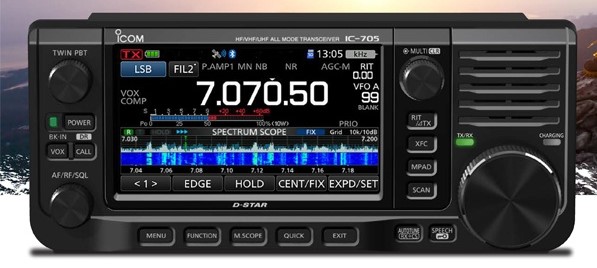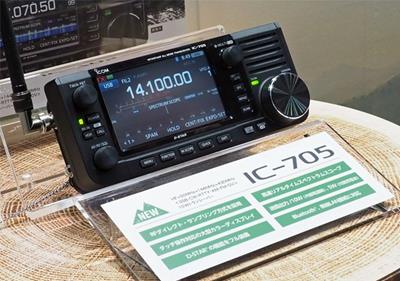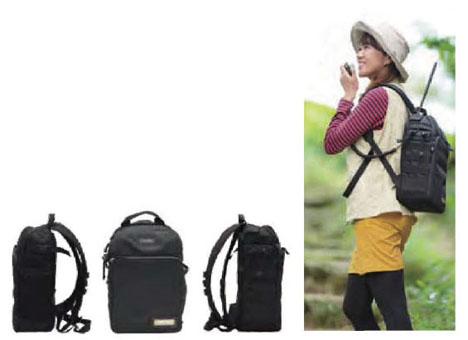I just published an announcement about the new Icom IC-705 portable transceiver, but omitted an important question for SWLing Post readers:
How well could the IC-705 serve shortwave listeners and DXers?
Keeping in mind that the IC-705 is not yet in production, we can only go by the features and few specifications Icom has revealed so far.
Since the IC-705 is a general coverage receiver with a frequency range from 0.5 to 148 MHz, it covers all of the shortwave bands and more.
We also know the IC-705 is based on the same direct-sampling architecture as the excellent IC-7300 (click here for our review), thus I expect the IC-705 will sport a capable receiver.
Icom’s other direct-sampling radios have excellent sensitivity and selectivity, so I assume the IC-705 could as well. I would also hope that, like the IC-7300, the AM bandwidth could be widened for full-fidelity AM audio–this has been one of the few criticisms I’ve had using the Elecraft KX3 and KX2 for shortwave listening.
The IC-705 sports other features that could make it an outstanding package for for DXers:
- It has built-in audio recording to a MicroSD card. (Woo hoo!)
- It has a useful, full-color, configurable spectrum and waterfall display
- It uses the same BP-272 Li-ion Battery pack as the ID-51 and ID-31 series handy talkies. In receive-only, I would expect long battery-powered listening sessions. Of course, you can also plug in an external 13.8 V battery to increase off-grid listening time.
- It’s incredibly portable and lightweight
In short, the IC-705 has all of the makings of a fully self-contained shortwave listening station–a grab-and-go DXpedition-grade rig. The IC-705 even has an (optional) custom Icom backpack!
Let’s just hope the IC-705 performs as well as its larger siblings and that its price is competitive.
Again, I plan to review the IC-705 once it’s released and in production. Both pricing and shipping are yet to be announced. Follow the tag IC-705 for updates.




I think the radio is is going to be too expensive, probably above 1000 Euro’s in the E.U.
Out portable I use the FT-891, it has a great receiver with fantastic DNR, it has an effective bandscope and it can output 100 watts or 10 if I want, this is great. Sure it consumes 0.9 amps on receive but battery tech is good enough these days that an 10 Ah Lithium battery could power a 100 transceiver at full power for many hrs. Or run up to 50 watts with a 5 AH battery for many hrs. LiPo can be got really cheap, a 3S 5ah Lipo battery can cost about 50 Euro’s or less. You could even run at 100 watts with 5 ah LiPo brick for a few hrs, Lipo can provide huge power. SSB consumes on average about 16 amps max with maybe some 20 amp peaks.
So I can see the appeal to the IC-705 , it looks nice, and has 10 watts but only with external power so if you need an external battery anyway why not the FT-891 ? it’s incredibly compact for a 100 watt radio.
The batteries are seriously over proved for the 705 .
I would have liked to have a small portable radio capable of 20-50 watts with a much larger battery, the Xiegu X5105 battery can power that radio for many hrs. After 5 hrs continuous use I still had charge. A great radio that fits into a tecsun PL-660 pouch, that an a portable end fed half wave from hyendcomany.nl provides a truly portable setup.
The IC-705 might be nice as a bedside radio, it looks good and the waterfall is convenient but I think a more basic HF only option would be better , at least for me. Stick a EFHW out the window and you can talk in bed or from the armchair.
I just purchased an YouLoop passive antenna thinking it would work with any portable receiver, however I realized after reading other information on this loop that you need an SDR type receiver such as Airspy, etc. Since the new Icom 705 transceiver is considered a SDR receiver, would the YouLoop work with the Icom 705 then? What am I missing here?
Regards,
Jerry
I’m guessing it might work well with the IC-705. I will try it when I get an IC-705. It really doesn’t have so much to do with it being an SDR–it does require a high dynamic range receiver, however. It’s possible it might perform well with some portables–perhaps others can comment with their experience.
Thomas
Its a field portable ham radio transceiver with some great features and will serve double duty for SWLing as well.
But come on guys you cant compare this to an SDR Play or Airspy or even a Persues. They are two very different things.
If you enjoy lugging your laptop and SDR Play to the beach to listen to the Indonesians coming in on grey line then I will enjoy taking tbe 705 out for some beach lounge DXing
I recall my Icom R70 and 71 had poor audio and needed the Don Moman and Kiwi mods to make them HiFi but their DX machines not big tabletop Grundigs
I remember when 60m was a DXers paradise now I am lucky to hear Brazil on 25m
The text interface seams to be having issues with the > sign when more than one is used in a sentence.
The next to last sentence (last displayed) should read: …lower frequencies, or longer wavelengths such as 25m, not…
The specs for the IC-705 as shared on Giga Parts website, “*Down-conversion IF sampling method for 25 MHz and above” and from the Universal Radio website and per conversation, from the Icom brochure, are confusing since it states the SDR function requires down converting for >25MHz when on the SDR radio’s I have used, except for receivers such as the SDRPlay and SDRPlay RSP2, the down converter is used for the opposite condition, that being for lower frequencies or longer wavelengths such as 25m” not “>25MHz”.
Has the ic-705 got à BFO?
Sir
Absolutely. It’s a full amateur radio transceiver, this optimized for SSB and CW reception.
Lovely radio
But it for the listener does it really offer more than i mid/high end SDR like SDRplay or airspy at a much lower price?
Hi, Jem,
Good question.
So I’m actually putting together a portable SDR station at the moment and would certainly argue that it’s a brilliant and more affordable solution than the IC-705 in many respects (ability to capture spectrum recordings, record multiple audio tracks simultaneously, full adaptive spectrum display, etc.).
Where a radio like the IC-705 would come in handy is when you would want an all-in-one setup with a traditional encoder (tuning knob) and “buttons and knobs” radio. As a bonus, you would actually have a useful spectrum display as well on the IC-705.
In a sense, I see it as an apples to oranges comparison. I think a portable SDR (like the SDRplay or AirSpy) is more robust, but if you’re a ham and an SWL, the IC-705 would make for a very portable DXing station as well.
Cheers,
Thomas
An automatic antenna tuner is usually only good for setting the SWR for transmitting (else one could fry the transmitter using a badly tuned antenna at the wrong frequency). Leaving it out, their thinking must be that any internal ATU would only adjust for SWR’s up to about a ratio of 4:1, so might be less useful on such a wide choice of frequency bands. Better ATU’s cover ratios over 100:1 but that adds to the weight to carry and power needed to supply the ATU in a backpack. For SWL use, it might be better to use an outboard preselector which may work almost as well as an antenna tuner (or an amplified one like an active antenna if you are in the field away from noise). But of course, one cannot transmit through the preselector without instantly frying it.
I have also heard the IC-7300 audio and it can sound harsh after a while, typical of many SDR based receivers. Actual listening tests would probably help a prospective buyer if audio fidelity is an important feature. That is why I am leaning more towards Kenwood equipment since it does sound better to my ears, aesthetically.
I agree completely about Kenwood–their audio is consistently top-shelf. Ten-Tec rigs have also produced beautiful audio in the world of transceivers.
Thanks for your comment.
Cheers,
Thomas
I think the idea of not including an ATU is a major mistake. First look at the size of a KX2 with a very broad band ATU. So an ATU is this radio should have not been an afterthought. Watch YouTube videos where hams set up portable. Take note to how many hams use either non resonant antennas or antennas that do not offer a perfect match. These hams are a big part of the QPP / Portable community.
I use only matched resonant antennas and this radio not having an ATU is a deal breaker for me. There are times my antennas are not placed in an optimum location and an ATU is needed.
I do have to say that the 705 does in fact have a lot of great features. A one radio do all does intrigue me.
Barry, KU3X/QRP
I own a ‘7300 and I am rather annoyed with its absence of low frequency audio response in AM receive mode. Where I see it is in FLDigi’s waterfall display. From what I can tell the roll off happens about 150 Hz. Surprisingly, low audio frequency response is better in SSB modes where it might go as low as 65 Hz. I recorded a music show from WRMI a few months back (in AM) and it was easy to hear the lack of low end in the audio. Oh, you can set the passband for very wide response, but you can’t do anything to correct LF receive audio. I’m using the USB audio driver from Icom on Windows. Since the rig is really not designed for the SWL market this “feature” is not going to be an issue with most if not all amateur radio operators.
If the ‘705 design is going to be similar to the ‘7300’s I would be wary of it’s use by SWL’s.
Thanks for your note, Al. Very interesting. Is there a setting to change the EQ levels of the RX audio? I know you can with TX, of course. For some reason, I thought RX audio could be adjusted, but perhaps I’m wrong.
-Thomas
Thomas, thanks for you comment! I couldn’t find a RX audio eq setting in the menu. Like you said, perhaps I’m wrong, too 🙂 I posted a question about it on FB ‘7300 group and didn’t get much help other than how to set the TX EQ….and other suggestions to read the manual. Sigh…..
–Al
And I thoroughly searched the manual and couldn’t find a reference to audio EQ. Seems like that would be an easy addition. 🙂 Let me know if you hear something new.
Cheers,
Thomas
Thomas, I think I read on the 7300 group that the receive audio response is rolled off in hardware, and can’t be changed unless you are willing to do some surgery on the SMD components.
Personally I do not think the IC-705 will approach being the SWL’s holy grail radio unless it includes an effective Synchronous AM mode, with selective wideband. Sure, you can always tune in USB or LSB with a stable radio, but that gets cumbersome after a while.
Good points. I suppose it has the potential to be one of the better portable transceivers for SWLing. I’ll send Icom a note about the roll-of. Perhaps they’ll take this into consideration.
Looks like they did listen to Thomas! 🙂
No, seriously – I checked on my cans and there is definitely no 200Hz rolloff in the AM audio, bass is as fat as it should be and if it isn’t enough…
…the actual radio has a bass+treble EQ and an additional “RX LPF/HPF” rolloff filter couple *for each mode independently*. The LPF part seems to mimic what some SDR softwares call “analog” mode, it has a maximum upper cutoff frequency of 2400 Hz and gently starts to take out the harshness of the full-range processing above that frequency. That means you can set your IF filter to 10 kHz and enjoy most of the treble response but still get rid of any unnecessary wideband noise portions and harsh distortion harmonics beyond that range.
Of course, the bass EQ is pretty pointless on the small speaker but the 705 sounds really great on headphones (or a good external speaker)!